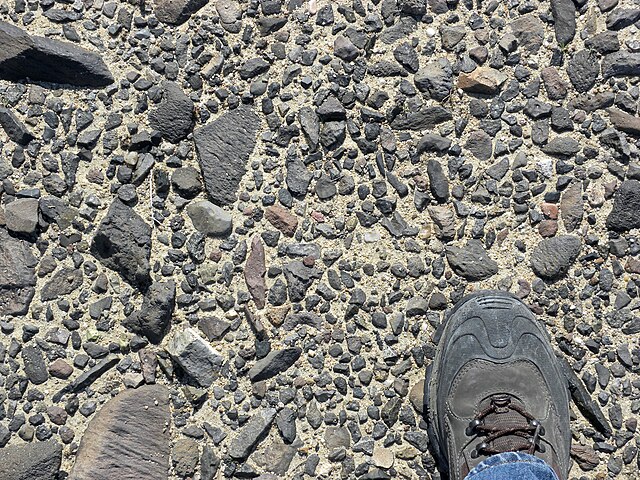Top Qs
Timeline
Chat
Perspective
Desert pavement
Type of desert earth surface From Wikipedia, the free encyclopedia
Remove ads
A desert pavement, also called reg (in western Sahara), serir (in eastern Sahara), gibber (in Australia), or saï (in central Asia)[1] is a desert surface covered with closely packed, interlocking angular or rounded rock fragments of pebble and cobble size. They typically top alluvial fans.[2] Desert varnish collects on the exposed surface rocks over time.


Geologists debate the mechanics of pavement formation and their age.
Remove ads
Formation
Summarize
Perspective
Several hypotheses have been proposed for the formation of desert pavements.[3] A common hypothesis suggests that they form through the gradual removal of sand, dust and other fine-grained material by the wind and intermittent rain, leaving the larger fragments behind. The larger fragments are shaken into place through the forces of rain, running water, wind, gravity, creep, thermal expansion and contraction, wetting and drying, frost heaving, animal traffic, and the Earth's constant microseismic vibrations. The removal of small particles by wind does not continue indefinitely, because once the pavement forms, it acts as a barrier to resist further erosion. The small particles collect underneath the pavement surface, forming a vesicular A soil horizon (designated "Av").
A second hypothesis supposes that desert pavements form from the shrink/swell properties of the clay underneath the pavement; when precipitation is absorbed by clay it causes it to expand, and when it dries it cracks along planes of weakness. Over time, this geomorphic action transports small pebbles to the surface, where they stay through lack of precipitation that would otherwise destroy the pavement by transport of the clasts or excessive vegetative growth.
A newer hypothesis suggests that desert pavements form through depositions of windblown dust atop preexisting rocks. The dust then settles beneath the rocks, forming a layer of soil, while the rocks at the top crack and begin to merge into desert pavement. In 1995, researchers conducted a study in the Mojave Desert using helium-3 dating where they determined the rocks to be of older age than the soil beneath, leading to the conclusion of "stone pavements [being] born at the surface."[4]

Desert pavement surfaces are often coated with desert varnish, a dark brown, sometimes shiny coating that contains clay minerals. In the US a famous example can be found on Newspaper Rock in southeastern Utah. Desert varnish is a thin coating (patina) of clays, iron, and manganese on the surface of sun-baked boulders. Micro-organisms may also play a role in their formation. Desert varnish is also prevalent in the Mojave desert and Great Basin geomorphic province.[5]
Remove ads
Local names

Stony deserts may be known by different names according to the region. Examples include:
Gibbers: Covering extensive areas in Australia such as parts of the Tirari-Sturt stony desert ecoregion are desert pavements called Gibber Plains after the pebbles or gibbers.[6] Gibber is also used to describe ecological communities, such as Gibber Chenopod Shrublands or Gibber Transition Shrublands. Pilungah Reserve, north-east Simpson Desert, 40km east of Minilya Roadhouse in Pilbara, Sturt Stony Desert.[7]
In North Africa, a vast stony desert plain is known as reg. This is in contrast with erg, which refers to a sandy desert area.[8]
Remove ads
See also
- Aeolian processes – Processes due to wind activity
- Desert varnish – Orange-to-black rock coating in arid environments
- Eduction (geology) – Sideways spreading in the Earth's crust, a mechanism of surface rock formation
- Erg – Broad area of desert covered with wind-swept sand
- Hamada – Desert landscape with mostly rock instead of sand
- Saltation (geology) – Particle transport by fluids
- Ventifact – Rock that has been eroded by wind-driven sand or ice crystals
Notes
References
External links
Wikiwand - on
Seamless Wikipedia browsing. On steroids.
Remove ads
